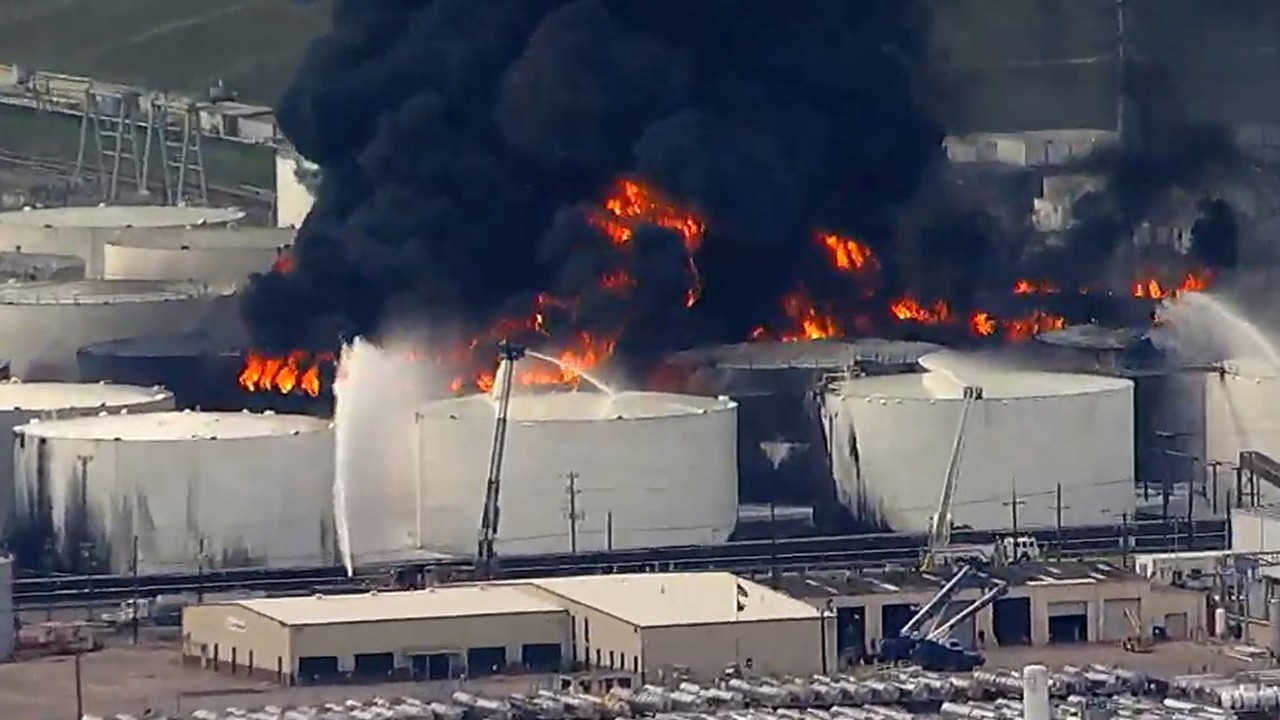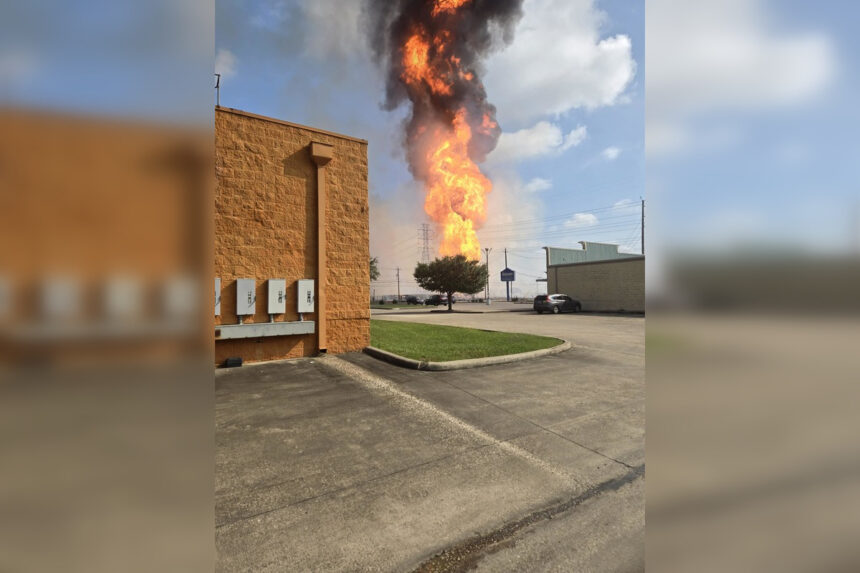In an unexpected and tragic turn of events, a massive pipeline explosion in Deer Park, Texas, just outside of Houston, sent shockwaves through the community on Monday. The blast, which led to a towering flame visible for miles, was the result of a vehicle crashing into a critical valve at a natural gas pipeline. With the explosion came a cascade of consequences—residents were evacuated, local schools and businesses were closed, and thousands of homes were left without power. What should have been a routine morning turned into a frightening ordeal for many as flames roared across the neighborhood.
This incident has opened up a wide range of discussions around public safety, industrial oversight, and the role of emergency response. Let’s delve into what transpired, how the community was affected, and the broader implications of this catastrophic event.
The Incident: A Tragic Accident
On Monday morning, the residents of Deer Park and La Porte, Texas, were met with terror as a loud boom shook their homes and a wall of flames emerged from a pipeline located along Spencer Highway near East Boulevard. The fire, which firefighters estimated could burn well into Tuesday, was triggered by an SUV crashing through a fence and striking a pipeline valve. According to officials, the pipeline, owned by Energy Transfer, was transporting natural gas liquids.
What should have been a minor vehicular accident quickly escalated into a major hazard, as the valve that was hit controlled the flow of gas in a 20-inch natural gas pipeline. Once the valve was damaged, gas leaked out and ignited, causing an enormous explosion that sent a plume of black smoke into the sky. The fire department responded immediately, but the intensity of the fire, fueled by natural gas, made it nearly impossible to extinguish. The only option was to wait for the remaining fuel in the pipeline to burn off, a process that was expected to last well into the next day.
Energy Transfer responded by lowering the pressure within the pipeline from 1,400 PSI to 200 PSI, but the residual gas continued to feed the flames. In their statement, the company said that the pipeline had been isolated to burn off the remaining product safely. Despite the controlled burn-off approach, the constant heat generated by the fire posed a significant risk to nearby homes.
Response from Local Authorities and Emergency Teams

Deer Park Mayor Jerry Mouton Jr. and other local officials were quick to respond to the incident. As the fire raged, firefighters and emergency responders were tasked with not only controlling the flames but also ensuring the safety of residents. Due to the magnitude of the fire and the proximity of the pipeline to residential areas, authorities had no choice but to order evacuations for homes and businesses within a half-mile radius of the explosion.
Hundreds of residents in the Brookglen neighborhood, located just steps away from the pipeline, were forced to leave their homes. Some described the sound of the explosion as deafening, followed by violent shaking. Savanna Lee, a local resident, said, “I heard a big boom and felt the house shake. I ran out of my bedroom, everyone’s freaking out. I open the front door, there’s this fire and I see the fence is on fire. And I was like, ‘We gotta go.’”
In addition to the evacuation of local homes, both Heritage Elementary and College Park Elementary were evacuated, along with a nearby H-E-B and Walmart. Faithbridge Church and the East Harris County Activity Center were set up as temporary shelters and cooling centers for those affected by the fire.
In a press conference later in the day, Mayor Mouton emphasized the challenges faced by firefighters as they worked tirelessly to control the fire and protect nearby structures. “The fire, it’s very hot, so a lot of the house structures that are adjacent to that are still catching on fire even though we’re putting a lot of water on them,” Mouton explained.
The Human Cost: Injuries and Displacement
While no fatalities were reported in the immediate aftermath of the explosion, several injuries did occur. Initially, authorities reported that one firefighter had been injured in the line of duty. However, later updates from Deer Park spokesperson Kaitlyn Bluejacket confirmed that four people, including a firefighter, were injured in the incident. Two of them were taken to local hospitals for treatment, though the severity of their injuries was not disclosed.
For many residents, the evacuation was disorienting and frightening. The explosion happened so quickly that many people had no time to gather their belongings before fleeing their homes. Geselle Melina Guerra and her boyfriend, Jairo Sanchez, described how they were sitting down to breakfast when they heard the blast. “All of a sudden we hear this loud bang and then I see something bright, like orange, coming from our back door that’s outside,” Guerra said. “We just drove as far as we could because we didn’t know what was happening.”
The temporary displacement of nearly 1,000 households added another layer of complexity to the disaster. Many residents sought shelter with family members or at the designated evacuation centers, while others were left wondering when they would be able to return home. For those living in the evacuation zone, the uncertainty of when they could return—and what they would find when they did—was a looming concern.
The Role of Energy Transfer: A History of Incidents

Energy Transfer, the company that owns the pipeline involved in the explosion, is one of the largest pipeline operators in the United States. Their operations span across multiple states, carrying crude oil, natural gas, and other petroleum products. However, the company has faced criticism over the years due to its involvement in several accidents and safety violations.
In 2022, Energy Transfer experienced a similar incident in Fort Bend County, Texas, when a pipeline caught fire. Furthermore, the company has had eight other incidents in 2024 alone, raising serious questions about its safety protocols and the adequacy of its infrastructure maintenance.
In the case of the Deer Park explosion, Energy Transfer has stated that the pipeline had been properly maintained and that the accident was caused by an external vehicle striking the valve. Nonetheless, the frequency of incidents involving the company has led many to demand stricter oversight and more stringent regulations governing pipeline operations.
For residents living near pipelines, these recurring accidents bring a mix of fear and frustration. One Deer Park resident interviewed by KHOU 11 expressed concern about living near so many pipelines. “We kind of knew the area, we know that it’s an industrial area, we know that there’s pipelines behind the house,” she said. “We have pipelines all over.”
Environmental Impact and Air Quality Concerns
Whenever an explosion or fire involves natural gas or other hazardous materials, environmental concerns quickly rise to the forefront. While authorities initially reported that there was no immediate danger from toxic gases, Harris County Pollution Control and Hazmat teams were dispatched to the scene to monitor air quality. Their primary objective was to ensure that residents and emergency responders were not exposed to harmful chemicals released by the burning gas.
Meteorologist Pat Cavlin from KHOU 11 explained that the lack of wind at the time of the explosion helped prevent the spread of smoke and flames. However, as the fire continued to burn, environmental experts stated that allowing the gas to burn off naturally was the safest course of action, despite the visible smoke and soot. In the days following the fire, residents would likely be watching air quality reports closely, especially those with respiratory issues.
The environmental impact of the explosion extends beyond air quality. The explosion also sparked a grass fire that burned a radius around the pipeline, creating additional hazards for nearby homes. As seen from aerial footage, several yards were scorched, and fire crews were forced to spray down homes to prevent further spread of the flames.
Power Outages and Ongoing Recovery Efforts

In addition to the fire and evacuations, the explosion knocked out power for thousands of customers in the area. CenterPoint Energy, the local utility provider, confirmed that more than 4,000 customers were left without power due to damage sustained to transmission lines and distribution poles. CenterPoint Energy emphasized that its operations were not connected to the natural gas explosion and that its crews were cooperating with emergency officials to ensure the area was safe before beginning repairs.
The restoration of power was a critical issue for residents who were already dealing with the anxiety of the explosion. With the fire continuing to burn, CenterPoint could not provide an exact timeline for when power would be restored but assured customers that crews would work quickly once given the all-clear by emergency responders.
Lessons Learned: Public Safety and Industrial Accountability
This tragic event in Deer Park highlights a larger issue that continues to plague industrial areas across the country—the potential danger posed by pipelines and other critical infrastructure. While accidents like these are often rare, when they do occur, the consequences can be devastating. The proximity of pipelines to residential neighborhoods raises important questions about public safety, zoning, and industry regulations.
For the residents of Deer Park, La Porte, and nearby communities, the fear and anxiety brought on by the explosion are unlikely to dissipate quickly. Many will undoubtedly continue to demand greater transparency from companies like Energy Transfer and stronger oversight from local and federal authorities.
This explosion serves as a stark reminder of the fine line between routine operations and catastrophe in areas with high concentrations of industrial activity. While the investigation into the Deer Park explosion continues, one thing is clear: the safety of pipelines and the communities they run through must remain a top priority moving forward.





